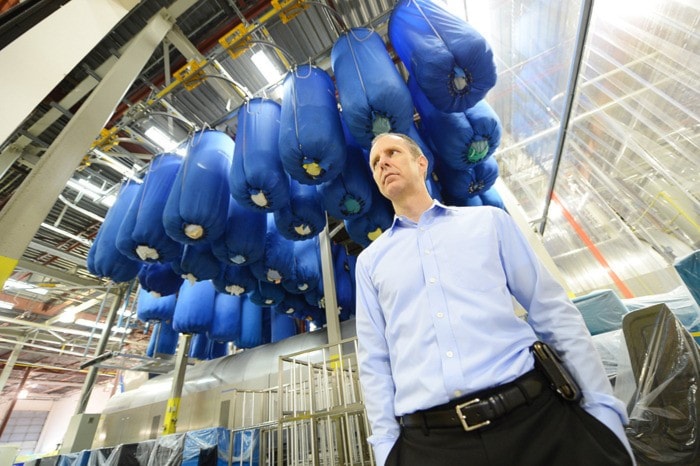 Anyone who operates a washing machine literally the size of a railway car is pretty serious about laundry.
Anyone who operates a washing machine literally the size of a railway car is pretty serious about laundry.
And having two such machines, just metres apart and operating 15 hours a day, seven days a week, makes for quite the laundry room.
Ron Graham can barely be heard above the rumbling of activity as he gives a visitor a tour of K-Bro Linen Systems Inc.
At 65,000 square feet, bigger than a football field, this is the larger of two company laundry warehouses in Burnaby that provide linens, linen delivery and linen-cleaning services to 18 hospitals and care facilities in the Lower Mainland and Fraser Valley.
K-Bro serves most major hospitals, with just a few exceptions: Langley Memorial, Peace Arch, St. Paul’s and Riverview.
While busy hospital staff may think nothing of the stuff they toss into the laundry hamper in the corner of the room or down the hall, there’s a massive engineering project behind the scenes that supports a critical area of medical care.
The operation has nothing in common with a household laundry room – not when there are four tractor-trailer units parked outside the loading bays.
Among the incoming piles to be processed: Assorted bedsheets, pillow cases, incontinence underpads, IV gowns, pajamas, towels, robes, washcloths, uniforms, lab coats, overalls, stretcher sheets, surgical drapes – virtually anything that’s made of cloth that a hospital will re-use.
Each day, Surrey Memorial Hospital alone produces about 4,500 kilograms (10,000 pounds) of linens that have to be washed by K-Bro.
The materials that come in are weighed, hand-sorted and separated into categories on conveyer belts and stuffed into hampers that look like blue elephant cocoons dangling from a computer-controlled monorail system on the ceiling.
Every two minutes, one 75-kilogram hamper (called a “sling” in-house) is opened, dropping its soiled contents into a slot on one side of the roof of one of the aforementioned “railway cars.”
Photo: Laundry delivery. 
The tunnel washer has compartments for 16 such 75-kilogram loads, and washes them more or less in tandem, like a giant screw moving through a tube – all in all, 3,600 kilograms (8,400 pounds) of laundry per hour for both tunnels.
Graham, the general manager and a K-Bro veteran who started as a company truck driver in Toronto 26 years ago, says that comparisons with household detergents, both in terms of ingredients and quantities, are meaningless.
Consumer detergents such as Tide, he explains, are “built” detergents with all ingredients for general use already in them.
K-Bro instead uses six different liquid chemicals (fed into the washers from enormous vats) and 60 programmed formulas for different linen materials (from cotton to polyester to more exotic surgical micro-fibres) and varying amounts of soiling (including blood, urine, feces and other fluids).
The six chemicals:
• Alkali: Breaks down the solid waste;
• Detergent: The soap suds help lift and separate the dirt materials during washing;
• Bleaching agent: Hydrogen peroxide, chlorine or citric acid;
• Optical brightener: Makes the whites a little bluer than true white;
• Fabric softener; and
• Souring agent: Adjusts the pH level to between 5.0 and 6.5 – slightly acidic, closer to the acidity of human skin, to make the linens more comfortable. (The municipal water supply is slightly alkaline, says Graham. “That’s something people don’t think about at home”).
With economy of scale and some nifty technology, all of this is better for the environment than in-house washing that used to be the norm in hospitals.
For one thing, the continuous-batch tunnel washer uses one-sixth of the water (per volume of laundry) of a conventional centrifugal washer.
Fewer chemicals are used, since they’re custom-tailored for specific wash loads so as to clean well but not over-wash.
The company also has a heat reclamation system in the boiler room – municipal water coming in is heated by outgoing water, and outgoing water is cooled by incoming municipal water (though the two sources are never mixed together).
As a load finishes its 32-minute wash through the tunnel, it’s squeezed-pressed into a hockey puck more than a metre wide before being sent via conveyer belt to one of seven dryers linked to each of the two washers.
After drying, washes are sent to another section of the warehouse, where dozens of workers sort, inspect, iron, fold and wrap the linens for shipping. A few stubborn items are treated and re-washed. A separate, isolated room is used to carefully inspect cloths used in surgery for holes or tears.
 Photo: Teresa Curammeng and Mabel Hung prepare items to be re-washed at K-Bro Linen Systems.
Photo: Teresa Curammeng and Mabel Hung prepare items to be re-washed at K-Bro Linen Systems.
Even though it’s possible for one item to be processed from hospital to laundry and back in 48-72 hours, the entire laundry process will take seven days in a complex chain of pick-up, sorting, washing, more sorting, storage, shipping and distribution.
One random washcloth sent from Surrey Memorial might end up in Vancouver General Hospital the following week, admits Graham.
That’s because the company pools most linens – K-Bro actually owns virtually all the items they wash – and redistributes them as needed.
It’s all part of a service contract with four regional health agencies that has several staff members at each hospital every day watching inventory and redistributing linens to the departments.
At SMH, there are four K-Bro members (out of a staff of about 220) on at any one time, and on average, one tractor-trailer unit of laundry comes out each day; VGH fills three trucks per day.
Graham admits that hospital laundry is something most people don’t think about.
“They system would break down without us.”
bjoseph@surreyleader.com
More in the series:
